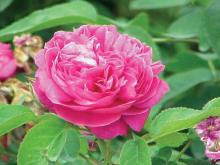There is more to Rosa damascena than its gorgeous flowers and lovely scent. Research on this cultivar is finding some intriguing properties that have potential for topical dermatologic products.
Rosa damascena, also known as the Damask Rose and Rose of Castile, is a rose hybrid the flowers of which have been used for rose oil in perfume and for rosewater.
It originates in the Middle East (the name is based on Damascus, Syria), but it is now only a cultivated plant and no longer found in the wild.
Bulgaria, Turkey, France, and India are the largest producers of rose oil. Rosewater has been used for centuries in religious rites and for physical, emotional, and spiritual purposes or healing. Thriving rosewater industries are found in Bulgaria and France.
In addition to its uses in the perfumery industry, R. damascena is also used for culinary purposes in several global cuisines. Geraniol, which exhibits potent antiseptic activity (seven times that of phenol), is the main constituent of several essential oils and is found in R. damascena (Hoffmann D., Medical Herbalism: The Science and Practice of Herbal Medicine. Rochester, Vt.: Healing Arts Press, 2003, p. 64).
Some of the earliest work to indicate the potential health and dermatologic benefits of R. damascena dates to the late 1970s.
Investigators isolated a strain of cultured cells of the plant that displayed strong resistance to UV radiation (254 nm) and generated a greater amount of polyphenols (primarily flavonoids) during the latter stages of culture growth. They found that this UV resistance was associated with increased polyphenolic production (Plant Physiol. 1979;64:936-41).
Flavonoids are the most prevalent and frequently studied polyphenols, which are the most abundant source of antioxidants in the human diet (Biomed. Pap. Med. Fac. Univ. Palacky Olomouc Czech Repub. 2003;147:137-45; J. Nutr. 2000;130 (8S Suppl):2073S-85S; Annu. Rev. Nutr. 2002;22:19-34; Pharmacol. Ther. 2001;90:157-77; Free Radic. Biol. Med. 2001;30:1213-22).
Antimicrobial Properties
In 2002, R. damascena was among eight essential oils studied for composition and antimicrobial characteristics. The antibacterial activities of the aromatic extracts were ascertained by disk diffusion testing. Among the standard test bacterial strains Escherichia coli, Staphylococcus aureus, and Pseudomonas aeruginosa, R. damascena showed antimicrobial activity against S. aureus (Arch. Pharm. Res. 2002;25:860-4).
Recent work has provided additional evidence of its antibacterial activity. In 2010, investigators tested 10 essential oils for antibacterial activity against Propionibacterium acnes as well as in vitro toxicology against three human cancer cell lines. Among the essential oils tested (which included mint, ginger, lemon, grapefruit, jasmine, lavender, chamomile, thyme, rose, and cinnamon) thyme, cinnamon, and rose were found to display the greatest antibacterial potency against P. acnes. Overall, the cytotoxicity of the essential oils was strongest against human prostate carcinoma cells (PC-3), as opposed to human lung carcinoma (A549) and human breast cancer (MCF-7) cells. Thyme was found to be the most cytotoxic to the cancer cell lines (Molecules 2010;15:3200-10).
UV Protection
In 2003, investigators assessed various extracts of R. damascena for its capacity as an antisolar agent in absorbing UV. The presence of flavonoids as the primary constituents of the extracts was verified before investigators identified the UV absorption spectra, with all three extracts found to be effective in absorbing UV in the 200- to 400-nm range. Next, the team incorporated the extracts into oil-in-water creams at 5% and 8% concentrations. The hydroalcoholic extract provided the highest sun protection factor (SPF), but the cream containing 5% ether extract rendered the most satisfactory appearance and stability. The authors ascribed the UV absorption ability of the extracts to the flavonoid constituents and noted that other synthetic antisolar compounds might be added to R. damascena extracts to enhance overall product efficacy (Int. J. Cosmet. Sci. 2003;25:259-65).
Antioxidant Properties
In 2005, Schiber et al. extracted and characterized flavonol glycosides from R. damascena petals following industrial distillation for essential oil recovery. After analyzing 22 constituents, kaempferol and quercetin were the only flavonoids (specifically, flavonols) detected, with kaempferol compounds accounting for 80% of the compounds measured. In noting the high flavonol content (approximately 16 g/kg in dry weight), the researchers concluded that R. damascena represents a promising source of natural antioxidants (Z. Naturforsch. C. 2005;60:379-84).
In a late 2010 study using a reversed-phase high-performance liquid chromatographic (RP-HPLC) method to simultaneously measure the flavonols, flavones, and phenolic acids as important constituents in various fruits, vegetables, and medicinal plants, R. damascena was identified as one of the species, along with Solidago virgaurea, Ginkgo biloba, and Camellia sinensis (the source of green tea), as having the highest flavonoid content (J. Agric. Food. Chem. 2010 Oct 4. [Epub ahead of print]).


